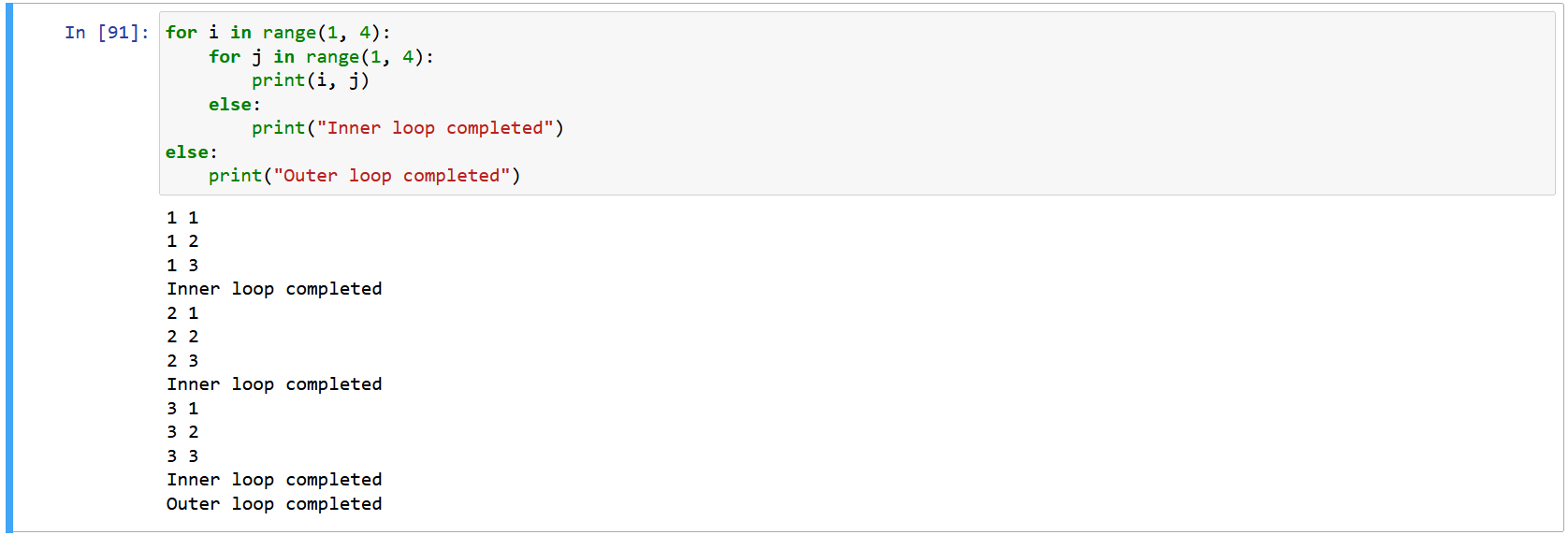
Welcome to the eagerly awaited 12th part of our Python series. If you’re new, be sure to check out our previous posts that cover data types, functions, modules, and error handling techniques.

Today, we’ll explore loop statements in Python, powerful tools for automating tasks and iterating over data structures efficiently. Whether you’re a novice or an expert, mastering loops is crucial for your Python skills.
So, get your coffee, relax, and prepare to delve into while loops, for loops, and nested loops in Python. After reading this, you’ll craft efficient loops for smoother programming. Let’s begin!
Ever repeated tasks in your Python code? Time to learn loop statements! Automate tasks and iterate data structures effortlessly.
Python provides not one, not two, but three types of loop statements:
Each of these loops has its own unique syntax and use cases, and in this blog, we’ll be exploring them all in depth. So, buckle up and get ready to take your Python skills to the next level with our comprehensive guide to mastering loop statements in Python!
While loops in Python repeatedly execute a code block as long as a specified condition holds true. They’re beneficial when the loop’s iteration count is uncertain beforehand.
The syntax for a while loop in Python is as follows:
while condition:
# code to execute
The loop checks the condition. If it’s true, the loop executes the code. This continues until the condition is false.

In this example, we initialize num as 1. The while loop prints num if it’s 5 or less, incrementing num after each iteration. This prints 1 to 5.
While loops are potent tools. They let you iterate until a condition is met, enhancing code efficiency and flexibility.
While loops are incredibly valuable in Python. Yet, how do you halt the loop prematurely or skip specific iterations? Here’s where the break and continue statements shine!
The break statement lets you exit a while loop instantly, regardless of the condition. This is handy when you’ve found your desired outcome and don’t need further iterations.

In this example, the while loop will print the numbers 1 and 2, but when it reaches 3, the break statement is executed and the loop is exited immediately.
The continue statement enables skipping specific loop iterations without exiting the loop completely. Useful for bypassing irrelevant items or data.
Here’s an example of how to use the continue statement in a while loop:

In this example, the while loop will print numbers 1, 2, 4, and 5. However, when it reaches 3, the continue statement executes, skipping the print statement.
Utilizing break and continue statements in your while loops grants you greater program control, leading to more efficient and effective code.
Using an else statement with a while loop in Python might seem unusual, but it proves highly useful in specific scenarios.
The else statement executes after the loop finishes all iterations, but only when the condition becomes false. This proves beneficial when you require an action after iterating through data, but only if the loop concludes entirely.
Here’s an example of how to use an else statement with a while loop:

In this example, the while loop will print the numbers 1, 2, 3, 4, and 5, and then execute the else statement to print “Loop completed!”. This only happens if the loop completes all iterations, i.e., num reaches 6.
You can also use the else statement with the break statement to execute code only when the loop is exited early. For example:

In this example, if the loop completes all iterations, it will print “Loop completed normally!”, but if the loop is exited early using the break statement, it will not execute the else statement.
By using the else statement with your while loops, you’ll have even more control over the flow of your program and be able to handle a wider range of scenarios.
Python features another crucial loop statement known as the for loop. It serves to iterate over sequences like lists, tuples, or strings, performing actions on each element.
The syntax of a for loop is as follows:
for variable in sequence:
# Do something with variable
The syntax involves assigning the variable the sequence’s elements in each iteration, and the loop’s code executes for each new variable value.
Here’s a simple example of a for loop that prints out each element of a list:

This example assigns the ‘fruit’ variable the value of each ‘fruits’ list element in each loop iteration. The ‘print’ function outputs the ‘fruit’ value. Utilize the for loop to iterate through sequences and perform actions on elements, enhancing programming versatility.
Alongside iterating sequences, such as lists and tuples, Python’s for loop can leverage the built-in range() function. This function generates number sequences for loop iteration.
for variable in range(start, stop, step):
# Do something with variable
In this structure, ‘start’ stands for the sequence’s starting value, ‘stop’ indicates the sequence’s end value (exclusive), and ‘step’ represents the interval between values (defaulting to 1 if unspecified).
Here’s an example of using the range() function with a for loop to print out the numbers 0 to 4:

Here, the range(5) function creates numbers 0 to 4 (inclusive), assigned to ‘i’ for each loop. ‘print()’ shows ‘i’. You can also set start and step in range().
For example, to print out the even numbers from 0 to 8, you can use the following code:

The range(0, 9, 2) generates even numbers from 0 to 8. Using the loop we assigns each to ‘i’. This combo is a powerful programming tool.
Similar to the while loop, break and continue statements work with for loops in Python. They control loop flow based on conditions.
The syntax for using the break and continue statements in a for loop is the same as in a while loop. Here’s a brief overview:
Immediately exits the loop and continues with the next statement in the program.
Skips the current iteration of the loop and continues with the next iteration.
Let’s take a look at an example of using the break statement with a for loop:

This example demonstrates a for loop iterating through the fruits list. If the current fruit is “cherry”, the loop breaks; otherwise, the fruit value is printed.
Here’s an example of using the continue statement with a for loop:

Here, the for loop goes through the fruits list. If the fruit is “cherry”, it skips to the next iteration using continue. Otherwise, it prints the fruit value.
Just like the while loop, Python’s for loop also includes an else statement. It executes after iterating through all items in the iterable.
Here’s the syntax for using the else statement with a for loop:
for variable in sequence:
# Code to be executed in the loop
else:
# Code to be executed when the loop is complete
In this syntax, the else block is optional and will only be executed if the loop has completed successfully (i.e., no break statement was used to prematurely exit the loop).
Let’s take a look at an example to see how the else statement works in a for loop:

In this example, the for loop iterates over the fruits list and uses the print() function to display the value of each fruit. Once the loop finishes, the else block runs, printing “No more fruits!” to the console. If the list were empty, the else block would execute right away. Employing the else statement in a for loop is handy for post-loop actions like resource cleanup or user messages.
The for loop in Python is a versatile construct that can be used to iterate over different data types, including lists, tuples, dictionaries, and strings. In this section, we’ll take a look at some examples of how to use the for loop to iterate over each of these data types.
Lists are one of the most commonly used data types in Python, and they are a natural fit for iteration using a for loop. Here’s an example:

In this example, the for loop iterates over the fruits list and uses the print() function to output the value of fruit to the console.
Tuples are similar to lists, but they are immutable (i.e., they cannot be modified once they are created). Here’s an example of how to use a for loop to iterate over a tuple:

In this example, the for loop iterates over the colors tuple and uses the print() function to output the value of color to the console.
Dictionaries are a key-value data type in Python, and they require a slightly different approach to iteration using a for loop. Here’s an example:

In this example, the items() method is used to iterate over the key-value pairs in the fruits dictionary. The for loop assigns the key to the fruit variable and the value to the count variable, and then uses the print() function to output both variables to the console.
Strings can also be iterated over using a for loop in Python. Here’s an example:

In this example, the for loop iterates over each character in the message string and uses the print() function to output the character to the console.
In conclusion, the for loop in Python is a powerful construct that can be used to iterate over different data types, including lists, tuples, dictionaries, and strings. By using the appropriate syntax and methods, you can easily iterate over these data types and perform a wide range of tasks.
In Python, a nested loop is a loop inside another loop. It allows you to iterate over multiple sequences or perform a repetitive task with different levels of complexity.
The syntax for a nested loop is straightforward. You have an outer loop that contains an inner loop. The inner loop will iterate over its sequence once for each iteration of the outer loop.
Here is an example of a simple nested loop:

In this example, we have an outer loop that iterates over the values 1, 2, and 3, and an inner loop that also iterates over the values 1, 2, and 3. For each iteration of the outer loop, the inner loop iterates over its sequence, printing the values of i and j to the console.
Nested loops are useful when you need to perform a repetitive task that involves multiple levels of complexity. They can be used for a wide range of applications, including processing multi-dimensional data structures, generating patterns or combinations, and performing mathematical calculations. However, be careful not to create overly complex nested loops that can lead to performance issues and hard-to-read code.
In Python, you can use the break and continue statements within a nested loop to control the flow of execution. The break statement can be used to exit the innermost loop or terminate the entire loop if it’s inside the outermost loop. The continue statement, on the other hand, skips the current iteration of the inner loop and moves on to the next one.
Let’s take an example to understand this better:

In this example, we have an outer loop that iterates over the values 1, 2, and 3, and an inner loop that iterates over the values 1, 2, and 3. However, the break statement is used to terminate the inner loop if the value of j is equal to 2.
Similarly, you can use the continue statement to skip certain iterations of the inner loop based on some condition.

In this example, the continue statement is used to skip the iteration of the inner loop if the value of j is equal to 2.
In conclusion, the break and continue statements can be used in nested loops to provide more control over the flow of execution and improve the efficiency of your code.
In Python, you can also use the else statement with nested loops to execute some code if the inner loop completes all its iterations without encountering a break statement. The else statement in a nested loop is executed after the inner loop has completed all its iterations for each iteration of the outer loop.
Here is the syntax for using the else statement with a nested loop:

Let’s take an example to understand this better:

In conclusion, you can use the else statement with nested loops to execute some code when the inner loop completes all its iterations without encountering a break statement. This can be useful when you need to perform some final tasks after the inner loop completes.
Python provides two main loop statements: the while loop and the for loop. While both repeat code, they suit different situations.
The while loop repeatedly executes code while a condition is true. It checks the condition, executes, and repeats if true. It stops when false.
The for loop executes code a fixed number of times or over items. It iterates over a sequence like a list, tuple, or string.
Both loops have strengths. Choosing the right loop enhances efficiency and readability in your code.
In summary, loop statements are crucial in programming. Python offers while loops, for loops, and nested loops. While loops work for unknown iterations, for loops for known. range() pairs with for loops. Use break/continue to control, else for completion. Nested loops handle multiple iterations.
Understanding these loop statements in Python is crucial for any programmer, and using them effectively can make the code more efficient and easier to read. Overall, mastering the use of loop statements in Python is a vital skill for any developer, and we hope this blog has provided you with a comprehensive overview of these statements. Thanks for taking your time to read and visit 1stepgrow.
We provide online certification in Data Science and AI, Digital Marketing, Data Analytics with a job guarantee program. For more information, contact us today!
Courses
1stepGrow
Anaconda | Jupyter Notebook | Git & GitHub (Version Control Systems) | Python Programming Language | R Programming Langauage | Linear Algebra & Statistics | ANOVA | Hypothesis Testing | Machine Learning | Data Cleaning | Data Wrangling | Feature Engineering | Exploratory Data Analytics (EDA) | ML Algorithms | Linear Regression | Logistic Regression | Decision Tree | Random Forest | Bagging & Boosting | PCA | SVM | Time Series Analysis | Natural Language Processing (NLP) | NLTK | Deep Learning | Neural Networks | Computer Vision | Reinforcement Learning | ANN | CNN | RNN | LSTM | Facebook Prophet | SQL | MongoDB | Advance Excel for Data Science | BI Tools | Tableau | Power BI | Big Data | Hadoop | Apache Spark | Azure Datalake | Cloud Deployment | AWS | GCP | AGILE & SCRUM | Data Science Capstone Projects | ML Capstone Projects | AI Capstone Projects | Domain Training | Business Analytics
WordPress | Elementor | On-Page SEO | Off-Page SEO | Technical SEO | Content SEO | SEM | PPC | Social Media Marketing | Email Marketing | Inbound Marketing | Web Analytics | Facebook Marketing | Mobile App Marketing | Content Marketing | YouTube Marketing | Google My Business (GMB) | CRM | Affiliate Marketing | Influencer Marketing | WordPress Website Development | AI in Digital Marketing | Portfolio Creation for Digital Marketing profile | Digital Marketing Capstone Projects
Jupyter Notebook | Git & GitHub | Python | Linear Algebra & Statistics | ANOVA | Hypothesis Testing | Machine Learning | Data Cleaning | Data Wrangling | Feature Engineering | Exploratory Data Analytics (EDA) | ML Algorithms | Linear Regression | Logistic Regression | Decision Tree | Random Forest | Bagging & Boosting | PCA | SVM | Time Series Analysis | Natural Language Processing (NLP) | NLTK | SQL | MongoDB | Advance Excel for Data Science | Alteryx | BI Tools | Tableau | Power BI | Big Data | Hadoop | Apache Spark | Azure Datalake | Cloud Deployment | AWS | GCP | AGILE & SCRUM | Data Analytics Capstone Projects
Anjanapura | Arekere | Basavanagudi | Basaveshwara Nagar | Begur | Bellandur | Bommanahalli | Bommasandra | BTM Layout | CV Raman Nagar | Electronic City | Girinagar | Gottigere | Hebbal | Hoodi | HSR Layout | Hulimavu | Indira Nagar | Jalahalli | Jayanagar | J. P. Nagar | Kamakshipalya | Kalyan Nagar | Kammanahalli | Kengeri | Koramangala | Kothnur | Krishnarajapuram | Kumaraswamy Layout | Lingarajapuram | Mahadevapura | Mahalakshmi Layout | Malleshwaram | Marathahalli | Mathikere | Nagarbhavi | Nandini Layout | Nayandahalli | Padmanabhanagar | Peenya | Pete Area | Rajaji Nagar | Rajarajeshwari Nagar | Ramamurthy Nagar | R. T. Nagar | Sadashivanagar | Seshadripuram | Shivajinagar | Ulsoor | Uttarahalli | Varthur | Vasanth Nagar | Vidyaranyapura | Vijayanagar | White Field | Yelahanka | Yeshwanthpur
Mumbai | Pune | Nagpur | Delhi | Gurugram | Chennai | Hyderabad | Coimbatore | Bhubaneswar | Kolkata | Indore | Jaipur and More